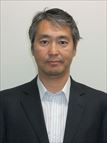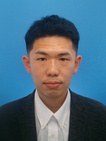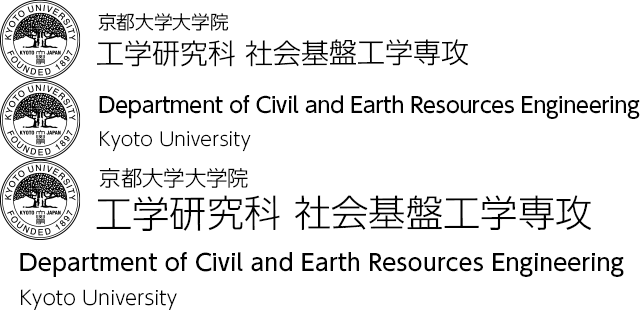Structural Mechanics
The keywords for this laboratory are "Earth and Human" and "Mellowness" looking for developing "beautiful" , "rich" , "pleasant" , "safe", "wholesome" and "energetic" societies. The laboratory is conducting static and dynamic studies as related to structural design and structural mechanics on the short-, middle- and long-term view points flexibly following the socio-cultural developments leading to the heritage of cultural, social and environmental assets under the general philosophy of sustainable development.
The main targets of the studies are to clarify the processes of load distribution and deformation and time-dependent change of strength and serviceability of structures.
Academic Staff
Yasuo KITANE
 Professor (Graduate School of Engineering)
Professor (Graduate School of Engineering)
Research Topics
Steel structures and composite structures are areas of research interest. Current research topics include remaining load carrying capacity and repair method of corrosion-damaged steel structures, damage and load carrying capacity of steel bridges subjected to fire, and applications of fiber reinforced polymers to structural members in civil structures.
Contacts
Room 252, Bldg. C1, Katsura Campus
TEL: +81-75-383-3160
FAX: +81-75-383-3163
E-mail: kitane.yasuo.2x![]() kyoto-u.ac.jp
kyoto-u.ac.jp
Risa MATSUMOTO
 Assistant Professor (Graduate School of Engineering)
Assistant Professor (Graduate School of Engineering)
Research Topics
My research topic is evaluation of improved fatigue strength by control of residual stress, establishment of design method of composite patch repair of cracked steel bridge and development of one-side repair method of fatigue crack.
Contacts
Room 251, Bldg. C1, Katsura Campus
TEL: +81-75-383-3161
FAX: +81-75-383-3163
E-mail: matsumoto.risa.8z![]() kyoto-u.ac.jp
kyoto-u.ac.jp
Akihiko SATO
Assistant Professor (Graduate School of Engineering)
Research Topics
I conduct research into the application of new materials, mainly fiber-reinforced plastics (FRP), to structural members. I am also working on research to evaluate the soundness of bridge structures based on their mechanical response.
Contacts
Room 253, Bldg. C1, Katsura Campus
TEL: +81-75-383-3162
E-mail: sato.akihiko.2x![]() kyoto-u.ac.jp
kyoto-u.ac.jp
Research Topics
Development of international on-line parallel pseudo-dynamic testing
The space which extends to several ten thousand km above the surface of the Earth from 20km below the surface which have not been fully utilized until now seems to be the new frontier for the 21st century. The precise study on the dynamic interaction among fluid (e.g., water and wind)-soil-structures is necessary in order to enable the utilization of such new space. Consequently, an international on-line parallel pseudo-dynamic testing which connects facilities for water tank tests, wind tunnel tests, geomechanical tests, structural tests through networking seems to be effective in order to consider the dynamic interactions (left figure of figure 1).
Through the recent development of the information science technology with the worldwide improvement of the Internet, rapid information sharing has been facilitated using computer network. Therefore, since information can be transmitted precisely and quickly through the computer network, the above mentioned large-scaled experiment which was only a dream in the past seems to have become a reality under distributed environment by remote control.
In fact, an international on-line pseudo-dynamic testing was conducted connecting experimental facilities of both Korea Advanced Institute of Science and Technology (KAIST) and Kyoto University through the Internet as shown in right figure of figure 1. In this test, seismic response behavior of an isolated elevated bridge with LRB (Lead Rubber Bearing) was clarified. It was thus verified that this testing system works efficiently.
By using this experimental technique, it may be possible to evaluate and examine the dynamic interaction of multi-degree of freedom structure, and it seems to greatly contribute to the elucidation of complicated physical phenomenon on the earth through international research collaboration.

Figure 1. Concept of international on-line parallel pseudo-dynamic testing (left figure) and the verification testing (right figure)
Elucidation of mechanical behavior of steel and composite structures and development of a rational design method
Because steel has excellent strength and ductility, it is one of the most frequently used structural materials. Many new materials have also been developed in recent years, and are being used as hybrid materials as combined with steel.
Steel is often used for thin and slender structural members because of its excellent properties. Therefore, mechanical behavior such as buckling phenomenon is important in steel and steel composite structures. Mechanical behavior of these structures is evaluated by loading tests and numerical simulations, and a rational design method is also developed.
Figure 2 shows the loading test (left figure) and the result of the numerical simulation (right figure) of steel rigid-frame pier. These results are in good agreement with the damages observed in the great Hanshin-Awaji Earthquake. Moreover, mechanical behavior of hybrid structures including corrugated steel PC web bridges is being studied.
Like human bodies, structures tend to deteriorate with time. Because of a huge stock of steel structures in Japan, the maintenance is becoming more and more important. Therefore, a study on the maintenance and anti-corrosion of the steel structures has recently started.

Figure 2. The loading test (left figure) and the result of the numerical simulation (right figure) of steel rigid-frame pier
Development of numerical analysis tools for dynamic response analysis of Very Large Floating Structures
In order to guarantee safety and serviceability of Very Large Floating Structures (VLFS) such as "Floating Bridge" and "Floating Airport", it is essential to estimate accurately dynamic responses of deflections, accelerations and stresses as well as rigid-body motions due to excitations by waves. In the analysis, dynamic fluid-structure interaction effect must be considered. Until now, many studies have been done on this topic, where only idealized models can be treated. However, in real projects, "response analysis for complicated models (complicated shape consisting of many structural components) with ultra-large degree of freedom" is required; which is still a very difficult problem to be solved even when we use a world top-class parallel computer.
Figure 3 shows numerically analyzed results of deflection amplitude (left figure) of pontoon-type VLFS (length=1,500m, width=150m) and snapshot for water-elevation (right figure) around the VLFS located in a real natural reef sea by newly-developed "accelerated Green's function method". In this numerical example, both variable sea-bed surface and wetted surface of the VLFS are discretized into panels with 67,098 unknowns, and solved by a parallel computer (IBM RS/6000 SP 5CPUs) with 38.4 hours. Now, research progress is under way for further acceleration of the method and extension to non-linear problems.

Figure 3. Deflection amplitude (left figure) of pontoon-type VLFS (length=1,500m, width=150m) and a snapshot for water-elevation (right figure) around the VLFS located in a real natural reef sea
